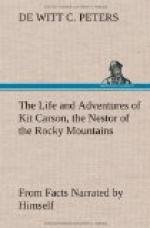During the cold weather, most of the Indians who dwell in the country adjacent to the Rocky Mountains, and especially those living on the eastern side of them, wear buffalo robes with the fur next to their bodies. These robes serve the double purpose of shirts or coats, and a covering by night. The wearers make them fast around the waist, and, in the heat of the day, they are allowed to fold over and hang down; but, as the cool air of the evening comes on, they are wrapped around the head and body, something after the Spanish fashion of wearing a cloak. The Indians, frequently, for the purpose of decoying their enemies into battle, go out on the prairies, and by turning the fur side of these robes out, and covering their persons, having previously assumed a half bent position, imitate the Simon Pure buffalo while in the act of grazing. In order to keep up the ruse, they move about with a rocking motion. When taken for the buffalo, which frequently happens, they are enabled to gain an advantage in approaching a party or village which they wish to attack. The Cheyenne Indians are very partial to loose sack-coats which are made out of white blankets. To these coats a hood is attached, which is thrown over the head at the wearer’s pleasure. In addition to this, during the winter season, they also resort to the buffalo robe. The squaws of the various tribes of Indians on the plains are well versed in the art of tanning and dressing buffalo hides. They frequently ornament them with beads, porcupine quills and rude paintings. In times long since gone by, these robes could be purchased, or rather traded for, at good bargains; but, the unlimited and increasing demand for them has greatly enhanced their value. Now days they bring standard prices.
Being satisfied that the Indians were in pursuit of us, we carefully guided our horses, at the same time using our spurs freely and keeping them at their maximum speed. As the Indians drew nearer, we could see distinctly that they were urging on their animals. Our safety, therefore, depended entirely on outriding them. The race became most exciting, and demanded the greatest caution, for we well knew, that one misstep made by either of our horses, would prove fatal to the rider. We had decided, on commencing the race, that neither of us should fire a shot except as a last resort, and that we should do it only on the principle of man for man. While putting our horses to their speed, our weapons were held in our hands and kept ready for instant service. The most dangerous point was that at which the two trails would inevitably intersect. To gain this place in advance of our savage enemies, all our hopes now centered. For twelve miles we dashed along, laboring under a state of suspense not to be easily forgotten. When, at last, we arrived at the desired point, we were only about two hundred yards in the advance of our savage pursuers; still, we felt that our lives, for the time being, were saved, and accordingly breathed




